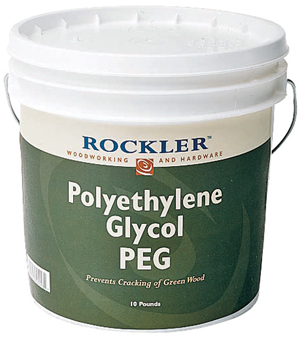
I have just acquired four 2-ft. cedar slab rounds that are 3-in. thick. The slabs were just cut fresh last week. I want to make a couple of outdoor tables from them and was wondering how to dry them without them cracking and splitting. Someone recommended PEG, but I’ve tried to find it and no one seems to have it. Is there something else I can use? How long will it take for them to dry? I do not want to put four legs on them so I was thinking about finding a root or gnarly tree branches to use as a base. Do you have any other suggestions? – Brad Swinton
Rob Johnstone: Rockler sells PEG (polyethylene glycol). Click here for a link to it. Without some sort of stabilizer like PEG, the chances of the rounds drying without some cracking (and more likely some pretty big cracks) is almost nil. The problem is that the fibers shrink at different rates in two directions (tangential and radial). That’s just physics: when the water leaves and the fibers get smaller, something has got to give. That is the rule of thumb — but as all of us who work with wood know, sometimes things just don’t happen like they should. So you will find some solid disks of wood that have dried in a mostly round shape with almost no cracks, and others with big, honking cracks. I don’t believe that this is predictable — certainly not by me.
Tim Inman: When water gets cold enough, it freezes. When wood dries out, it shrinks and cracks. Not much we can do to stop either one. Those slabs are just going to crack. You can’t stop Mother Nature. The only possible preventive measure is to use PEG, or something similar. For pieces that big, you’re looking at an industrial setting, or at least an industrial quantity of PEG. When you’re done PEGing, the wood will be waxy forever. Why not just accept the reality? My suggestion would be to make one radial cut to the center of each slice, and then let the wood dry. By providing the “stress relief,” you will encourage the wood to not crack in other places, and put all the shrink into one place. Then, after the wood has completed its drying phase, put in a filler to close the gap. Honesty in materials. Plan B would be to saw the slabs in half. Let them dry, and then joint the two faces flat and glue them back together.
Chris Marshall: There’s also the matter of what the sun is going to do to those cedar tabletops over time, even if you can arrest the cracking and splitting with PEG during this initial drying period. (Speaking of drying time, the typical rule of thumb is to allow a year for each inch of stock thickness for green wood, but this estimate varies quite a bit.) Ultimately, the sun will prevail and cause the wood to check as it ages. Prepare yourself for the wood to do what it will do, based on your choice of application. Still, even with some minor checking and cracks in the long run, your “organic” table design sounds cool. Go with it! A little “character” in the wood will add charm.





